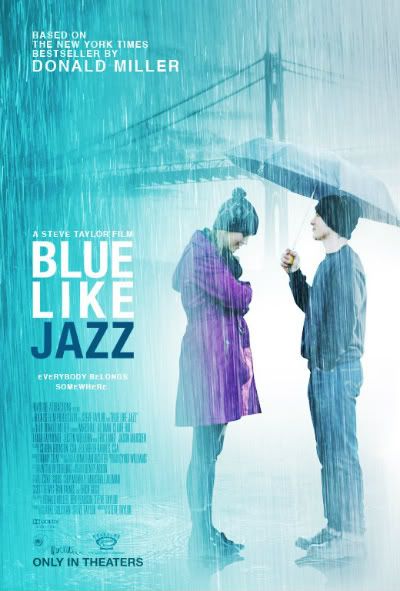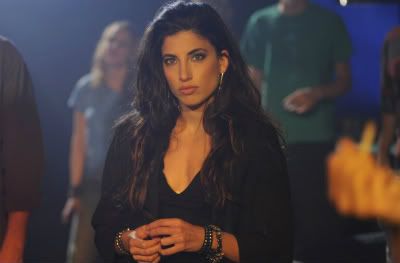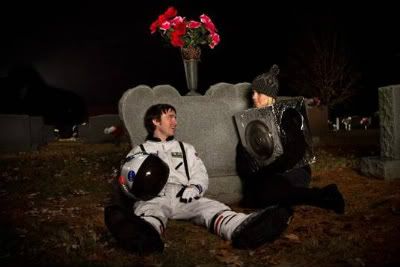
NOTE: No, you didn’t accidentally type the wrong website address. No, you didn’t accidentally click on some obscure hyperlink sneakily buried like an Easter egg in the middle of this webpage. No, your browser hasn’t been hijacked, either. And no, you didn’t just step into The Twilight Zone nor have your monitor’s transmission taken over by the producers of The Outer Limits. You are indeed on the “Scared Silly” page, home of my blog-to-book project wherein I set out to review as many classic Hollywood horror-comedies as possible from the silent era through the mid 1960s. So why have I posted a review of a brand-new, 2012 film with ample doses of comedy but no evident horror elements? The answer is simple: thanks to a Kickstarter fund raiser that you can read about here, I am an Associate Producer of the new film, “Blue Like Jazz.” and was privileged to see an early screening. Here is my review.
RATING: *** & ¼ out of ****
PLOT: Young Don is an assistant youth pastor in Texas facing several conflicts. His first conflict: a devout mother pushing him toward a Christian college education versus his vagabond-professor dad, estranged from his Mom and pulling strings to get him into one of the top liberal arts colleges in the country. His second conflict: when two people Don admires let him down – including most significantly his mother – he eschews his faith and decides to dive head first into the liberal arts college his dad endorses. But it’s not just any liberal arts college – it’s Reed College, where all bets are off The first day of school, the dean instructs his students to “forget everything” they’ve ever learned about anything. This especially includes matters of religion. Don sets out to “ditch God” in his freshman year but a series of events involving some of Don’s new friends force him to reassess and perhaps abandon his mission. Will Don’s life, his response to the faith in which he was raised and the way he treats others “resolve” or remain forever like “stars swirling in the blue,” unresolved like the freeform jazz albums to which he often listens?
REVIEW: “Blue Like Jazz” is based on the best-selling NY Times book of the same title by Donald Miller. The book is a rather freeform collection of autobiographical essays detailing the author’s struggles with faith, specifically the Christian faith, his belief in God and in Jesus and how he often had trouble reconciling the loving, graceful, merciful Jesus he read about in the gospel accounts of the bible with some of the contradictory, hypocritical attitudes he encountered along the way (including often his own) as he set out to live his faith. A large portion of the book relates tales of Miller's time auditing classes at Reed College, a liberal arts school in Portland Oregon.
The film is directed by Steve Taylor, who directed one previous feature film (2006’s “The Second Chance,” another favorite of mine) and recorded many music albums as a singer-songwriter-musician producer both within and outside of the Christian music industry. He made the natural segue from directing his own music videos and those of others to directing movies. Depending upon your viewpoint, Taylor is famous or infamous for his penchant to hold up an often bitingly satirical mirror to some of the uglier, more hypocritical examples he’s seen come from some church leaders and members through the years.
Both the book and movie of “Blue Like Jazz” exist I believe as an attempt to serve as a bridge between believers and non-believers to help them better understand one another. The book may have started as Donald Miller’s personal journey to resolve the conflicting feelings about Christianity within his own heart but in adapting it to a screen story where others’ conflicts, motives and deep personal feelings are also revealed the idea of reconciliation may ring even more true.
The film is very funny in spots, involving and thought-provoking. There is some genuine drama. In the end, it’s about how the characters respond to each situation and to each other, and how all those pieces relate to the bigger picture that form the heart of the film. In that way, this is one of those stories where the destination reached may be more important than the particulars of the journey along the way.
It’s worth mentioning the main characters and the actors that play them. Front and center of course is the semi-fictionalized version of the book’s author, Don Miller. Marshall Allman, known for his recurring roles in the TV series “Prison Break” and “True Blood” plays Don. His acting in the early scenes comes off just a tad uneven, but perhaps it was a conscious choice given the changes his character goes through. Ultimately he handles some tougher scenes toward the film’s end quite admirably and redeems himself, just as his character does the same.
William McKinney is Don’s friend Jordan from Texas. The two work at a plant that manufactures disposable communion cups pre-filled with grape juice (they look a bit like coffee creamers). Jordan starts as a bit of a ruffian poser but through a funny though perhaps unlikely situation goes through an extreme character change. Something that really changes his life in an impactful way and gets Don thinking a bit. Jordan's turnaround is the flipside to Don’s character starting out as believing in principles then giving way to reckless abandon in the face of adversity. Jordan's character adds an extra piece to Don’s puzzle of (re?)self-discovery.
Another pair of students at the school nicknamed “The Pope” (Justin Welborn) and “The Russian” (Matt Godfrey) are broad types at first (even within a scene where the college characters discuss archetypes vs. stereotypes in literature class – kind of an unintentional act of “meta”) but they eventually become more shaded characters into which the audience gets an extra glimpse of understanding. So much so that both figure prominently into the film’s ending.
There are two pairs of prominent non-student adult figures sprinkled into the mix as well, and they act as bookends for each other. On one side are Don’s mother (Jenny Littleton) and the head youth pastor Kenny (Jason Marsden). They are hiding behind self-righteousness and hiding some other things as well (their flaws come to the surface soon enough). On the other side are Don’s dad (Eric Lange) and the school’s dean (Jeff Obemi Carr). They aren’t hiding at all but rather flaunt their notion that they “know it all” with such certainty that you suspect the other shoe may drop one day and they’ll realize they’re only fooling themselves.
The two characters viewers may remember most are the two female leads. The combination of how the characters are written, the struggles they endure and the performances by the actresses that play Penny and Lauryn make them engaging, endearing and embraceable.
Penny (Claire Holt, “The Vampire Diaries”) factors in as the main catalyst toward Don reassessing the path of rebellion he’s been on and more importantly, encouraging him to redirect his gaze from inward to outward. Through Penny’s example, Don realizes that he needs to reach out more to others instead of constantly reaching in to fulfill his own needs. Penny gradually reveals herself and her true motivations. She is the model of grace toward Don even (and especially) when he seems none too deserving for his thoughtless actions. She becomes the true heart and soul of the movie, although she does have some company in the other female lead, Lauryn.

Lauryn (Tania Raymonde of “Malcolm in the Middle” and “Lost”) is a lesbian in a film made by Christians in which her character is not there for any other reason than to display love. First, in a great “flip” to how other screenplays may have handled a straight-gay relationship, it is Lauryn who is the first to befriend Don on campus. Although one can argue that her advice to “stay in the closet, Baptist boy” shows a lack of acceptance on her part, it’s only given because she knows the ropes of the place and is trying to protect Don from being immediately thrown to (and devoured by) the lions. Later in the film it is Don who shows love to Lauryn, comforting her during an emotionally difficult time for her. The Lauryn character would probably slap me for saying so, but Raymonde’s performance is radiant and easily makes her the biggest candidate for “break-out” status here.
Steve Taylor honed his behind-the-camera skills by directing music videos for his songs and those of others. This MTV-style of short, dynamic cuts serves him better in “Blue Like Jazz” than it did in “Second Chance.” Probably because it fits the chaotic, “anything goes” world of college partying and self-exploration shown in “Jazz” than it did the gritty realism of “Chance’s” inner city scenes.
Beyond the quick cuts we get a lot of of close-ups which is understandable due to the film’s low budget as well as the fact that it is a personal story revolving around people’s feelings rather than explosions and special effects. However, these alternate with some interesting visuals courtesy of the built-in conceit of the real Reed College’s famed “Renn Fayre.” This annual festival of debauchery takes place after final exams and is complete with students dressed in a variety of crazy costumes.
In fact, costumes become something of a theme in “Blue Like Jazz” as if Taylor really wanted some visually compelling images to adorn this introspective tale. Other examples are the Pope character that is clothed as his namesake throughout and a scene of “civil disobedience” in a bookstore that finds the students dressed as robots and astronauts (it’s telling that this particular protest by sweet Penny revolves around the notion that chain bookstores make it harder for less known indie writers to get read).

The animation fan in me is sated by the inclusion of a cleverly inserted scene that brings Miller’s cartoon strip story from “Blue Like Jazz” (“Don Rabbit and Sexy Carrot”) to life. A metaphor for Don (or anyone) relentlessly chasing after ill-conceived desires despite the danger that lies ahead, the scene is effectively inserted at a point in the story where Don makes a crucial decision.
The film is not without its flaws, but after reading the writings and interviews from the folks behind it I think they’d be disappointed if it didn’t have flaws, since having flaws is a big point of the story in the first place. I don’t think those flaws – minor at best - mar the film or lessen its impact. The biggest criticism I had when I first saw the film was that it appeared the filmmakers may have gone so out of their way to not appear to be playing favorites that they gave more “face time” to views that oppose Christianity as opposed to equal time to both views. After seeing the film a second time I changed my mind. Between the life-changing experiences of both Jordan and Penny and Don, especially those depicted in the very powerful third act I can honestly say I was wrong and that there is a real balance here.
I've read some reviews that call out the film's quirky humor as being "unrealistic" and compromising the drama of what the characters go through. I am reminded though of Wes Anderson's brilliant "The Royal Tenenbaums," filled with quirky humor yet also resonating with some affecting drama. I believe the "Blue Like Jazz" team pulled off a similar feat.
This film is rated PG-13. I would consider it a "hard PG-13" - it is very edgy and adult. It draws primarily from the parts of the book revolving around the no-holds-barred liberal arts college that author Miller attended (most of the action is set there). While I was never the party guy in college (for a variety of reasons) or even after college, these elements don't personally bother me so much as I realize that the filmmakers were trying to tell their story authentically and not potentially mute their message by whitewashing the context in which the story takes place. Context figures heavily into what is perhaps the film’s most controversial line of dialogue.
The line is the character Don saying, “I’m ashamed of Jesus.”
The line as it appears in the trailer, removed from its context, makes for a highly provocative statement that leads a viewer to wonder why the lead character would express this thought. However, when seen within the context of the entire scene and really the entire film, it becomes clear that Don is really saying he’s ashamed of himself. He says that once he realized who Jesus really is and what he requires of his followers, he and many other professing Christians simply missed the boat and have misrepresented Jesus.
This is one of those “mirror reflection” revelations that stings. Don makes a particular point of confessing that he’s never helped the poor, a key tenet of the faith, but instead bought into political movements and other distractions that kept him off-point. Don also owns up to his actions, confessing that he has indeed been consciously "trying to ditch God" his entire freshman year of college. It is through the examples of other characters and various situations that arise that Don comes to realize that the more he pulls away, the more Christianity is tugging at his heart. To embrace it, he concludes that he’s got to reach out to others (even and especially those that don’t share his beliefs) in a spirit of love and reconciliation.

This movie really resonated with me. I was raised in a nearly-idyllic small town in New Jersey. I was brought up Catholic but my evangelical friends got me into VBS and the Christian version of Boy Scouts at their church. By the time high school came around I was not only going to youth group but regularly attending a non-denominational bible church. The left turn came when I found myself going to college at one of the nation’s most renowned art schools. In New York City no less! Talk about culture shock. I can certainly attest first hand to the edgy content in “Blue Like Jazz” being authentic to a college experience.
The other way the film resonates with me is through Don’s shame. I admit that I too have been guilty of mistreating others even while convinced I was doing the right thing, the thing I thought God wanted me to do, think or say. Christ’s example – and the lesson Don learns in the film – is one of sacrifice of self in the interest of others. How will what I do/say/think affect the other person? It’s always the simple lessons in the bible – the ones so easy to forget or that we try to modify to fit our own selfish needs – it’s always those simple lessons that humble us and bring us back home to true loving behavior. Love your neighbor as yourself, don’t tear down others with harsh words, forget about that splinter in your neighbor’s eye and concentrate instead on removing that mega-high skyscraper girder from your own eye.
I do have to underscore here that families looking for the next “Facing the Giants” need to look elsewhere. By director Steve Taylor’s own admission, “Blue Like Jazz” is not a “family-friendly film.” It’s not even a “Christian film” in terms of how that phrase is used to market a certain “brand” of film that’s become defined by staying within certain parameters. “Blue Like Jazz” is an indie film from an indie film distributor, made by Christians with Christian themes as well as explorations of other viewpoints. It is meant to reflect real-life. Real life is messy for everyone no matter what their beliefs.
“Blue Like Jazz” is a film that pulls no punches. More than any other film about Christianity I've ever seen it's one I believe non-believers can enjoy and perhaps even embrace. Perhaps it will inspire believers and non-believers to be brought to a place of reconciliation where at least a civil dialogue can be had. I don't think every non-believer who sees this will embrace Christianity - I don't expect them to do so - but at the basic level of coming to a place of better understanding between those who believe differently from one another it's certainly a conversation starter and a step in the right direction. Just like Don apologizing for the Crusades in the movie’s dramatic confession booth finale.
“Blue Like Jazz” opens in theaters nationwide on Friday, April 13, 2012. Click here to find out where it’s playing in your area.


No comments:
Post a Comment